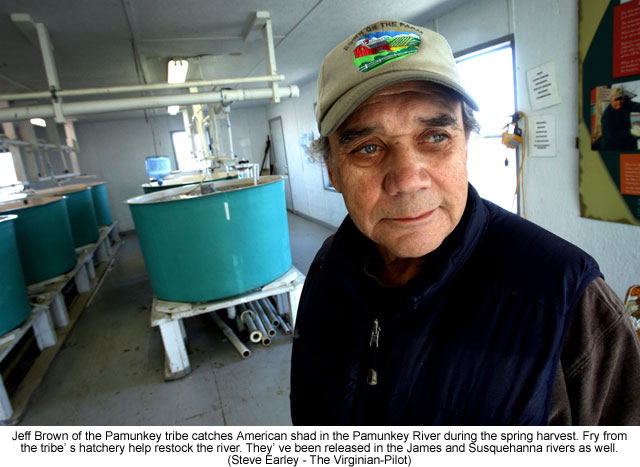 |
Canku Ota
|
 |
|
(Many Paths)
|
||
|
An Online Newsletter
Celebrating Native America
|
||
|
July 1, 2009 - Volume
7 Number 7
|
||
|
|
||
|
Spring Shad Harvest,
Every Year A Ritual Renewed
|
||
|
by Joanne Kimberlin
- The Virginian-Pilot
|
||
 Tribes’
ancestors relied on yearly spawning to satisfy winter’s hunger. Tribes’
ancestors relied on yearly spawning to satisfy winter’s hunger.
They return each spring, an ancient migration that slips upriver like a silvery plume of mercury. Once, the annual shad run meant full bellies after the lean of winter. Now, it’s more about extra income and the renewal of an old bond. A river runs deep through just about every Virginia tribe – its ancestral artery to food, transportation and escape, when necessary. Fresh water and sandy shallows in the Pamunkey and Mattaponi rivers draw the American shad – a fish that averages about 3 pounds and is prized for its bon y meat, strong enough to require little seasoning. Shad roe is also considered a treat, fetching about $12 for the twin, palm-size egg sacks carried by a single female. It’s those pale-pink eggs that send a shad upriver. Most of an adult’s life is spent at sea, but the eggs need a more suitable nursery. So when the spring sun warms the water, the shad come home to spawn. Unlike the better-known salmon of the North, shad don’t necessarily die in the spawning process, unless they’re caught in the drift net of a native. Indians are the only Virginians allowed to harvest American shad. Over fishing and pollution threaten the stock, restricting other anglers to catch and release. The Indians themselves practice conservation. Hatcheries on the Pamunkey and Mattaponi reservations have returned millions of young shad to the tribe’s rivers. Netted fish are milked for sperm and eggs, which are mixed together in a pan, incubated and hatched. Each female carries enough eggs to produce 100,000 offspring, but left on their own, few will ever see adulthood.
Finally, the fry are flushed down a pipe directly into the river, where they’ll remain until fall, then gradually head for saltwater. Shad are a big reason the tribes spent 15 years fighting a massive reservoir planned to supply drinking water to the Peninsula. The project, now on hold, would have flooded 1,500 acres between the two reservations and drawn up to 75 million gallons a day out of the Mattaponi River. Shad have been known to vanish from areas where man has altered nature’s delicate balance. Joanne Kimberlin, (757) 446-2338, joanne.kimberlin@pilotonline.com |
|
|
||
|
|
||
| Canku Ota is a free Newsletter celebrating Native America, its traditions and accomplishments . We do not provide subscriber or visitor names to anyone. Some articles presented in Canku Ota may contain copyright material. We have received appropriate permissions for republishing any articles. Material appearing here is distributed without profit or monetary gain to those who have expressed an interest. This is in accordance with Title 17 U.S.C. Section 107. | ||
|
Canku Ota is a copyright ©
2000, 2001, 2002, 2003, 2004, 2005, 2006, 2007, 2008, 2009 of Vicki
Barry and Paul Barry.
|
||
 |
 |
|
|
The "Canku
Ota - A Newsletter Celebrating Native America" web site and
its design is the
|
||
|
Copyright ©
1999, 2000, 2001, 2002, 2003, 2004, 2005,
2006, 2007, 2008, 2009 of Paul
C. Barry.
|
||
|
All Rights Reserved.
|
||
 A
hatchery improves their odds by providing shelter and food through
the first crucial weeks. When fry reach about 1 inch long, they’re
tagged with oxytetracycline, a chemical that stains an inner ear
bone and makes it possible to identify them later, helping a hatchery
track its own success.
A
hatchery improves their odds by providing shelter and food through
the first crucial weeks. When fry reach about 1 inch long, they’re
tagged with oxytetracycline, a chemical that stains an inner ear
bone and makes it possible to identify them later, helping a hatchery
track its own success.